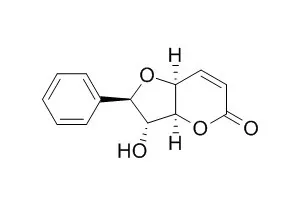| In vitro: |
| Phytother Res. 2012 Jun;26(6):926-31. | | Altholactone induces apoptotic cell death in human colorectal cancer cells.[Pubmed: 22105918] | Resistance of colorectal cancer (CRC) to the available chemotherapy reveals the demand for identification of new anticancer agents. We evaluated the antitumour potential of Altholactone, a naturally occurring bioactive compound isolated from Goniothalamus spp. (Annonaceae) hooks, against CRC cells.
METHODS AND RESULTS:
Antitumour activity of Altholactone was measured using 3-(4,5-dimethylthiazol-2-yl)-2,5-diphenyltetrazolium bromide assay and the propidium iodide method. Apoptosis mediators involved were assessed using biochemical inhibitors and Western blotting analysis. Results revealed that Altholactone induced varying degrees of apoptosis in CRC cells but not in normal fibroblasts. Dissection of the Altholactone-induced apoptotic signalling pathway revealed that Altholactone activated caspase-dependent and -independent apoptotic pathways. Activation of caspase-4 appeared to be the initiating event in the caspase-dependent apoptotic pathway. Pre-treatment of CRC cells with the antioxidant N-acetylcysteine (NAC) significantly inhibited activation of caspase-4 and Altholactone-induced apoptosis.
CONCLUSIONS:
These results indicate that Altholactone induces selective cytotoxicity against colon carcinoma cells and warrants further clinical evaluation. | | Molecules. 2011 Jun 3;16(6):4560-6. | | Altholactone displays promising antimicrobial activity.[Pubmed: 21642933] |
METHODS AND RESULTS:
The antimicrobial activity of Altholactone, a naturally extracted styryllactone isolated from Goniothalamus malayanus, was determined against Gram positive (S. aureus ATTC 25923, S. aureus ATTC 25392, and E. faecalis ATTC 29212) and Gram negative (E. coli ATTC 35218, S. typhi ATTC 14023 and P. aeruginosa ATCC 27853) reference bacteria and against the fungus C. albicans ATTC 10231. Different concentrations of Altholactone (0, 12, 25, and 50 μg/mL) were used. Results revealed that Altholactone inhibited the growth of all tested microbes except P. aeruginosa ATCC 27853 in a dose-dependent manner, with the highest cytotoxic effects occurring at 50 μg/mL. The average of the inhibition zones of the different concentrations was between 0-30 mm. Furthermore, Altholactone-induced antimicrobial activity against the more sensitive microbes was assessed by measuring the minimal inhibitory concentration (MIC). Results indicated that Gram positive (S. aureus ATTC 25923, S. aureus ATTC 25392, and E. faecalis ATTC 29212) cells were more sensitive to Altholactone than Gram negative ones (E. coli ATTC 35218, S. typhi ATTC 14023). C. albicans showed moderate sensitivity.
CONCLUSIONS:
These results indicate that Altholactone might be a potential antimicrobial agent, particularly in ciprofloxacin-refractory S. aureus and E. faecalis infections. Further investigations are required to illustrate the mechanism(s) by which Altholactone produces its antimicrobial effects. |
|






 Cell. 2018 Jan 11;172(1-2):249-261.e12. doi: 10.1016/j.cell.2017.12.019.IF=36.216(2019)
Cell. 2018 Jan 11;172(1-2):249-261.e12. doi: 10.1016/j.cell.2017.12.019.IF=36.216(2019) Cell Metab. 2020 Mar 3;31(3):534-548.e5. doi: 10.1016/j.cmet.2020.01.002.IF=22.415(2019)
Cell Metab. 2020 Mar 3;31(3):534-548.e5. doi: 10.1016/j.cmet.2020.01.002.IF=22.415(2019) Mol Cell. 2017 Nov 16;68(4):673-685.e6. doi: 10.1016/j.molcel.2017.10.022.IF=14.548(2019)
Mol Cell. 2017 Nov 16;68(4):673-685.e6. doi: 10.1016/j.molcel.2017.10.022.IF=14.548(2019)